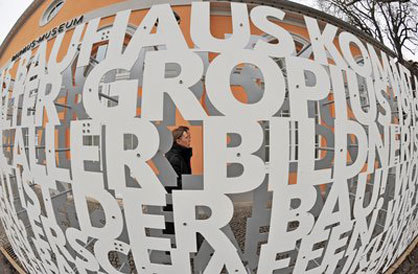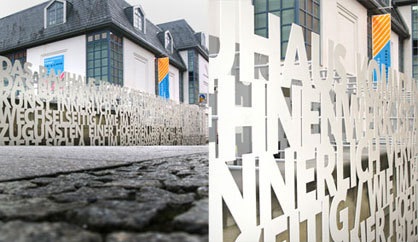The Bauhaus comes from Weimar
Texto por Klassik Stiftung Weimar
Alemania
11.05.09
Klassik Stiftung Weimar celebrates the 90th birthday of the founding of the Bauhaus
On the occasion of the 90th anniversary of the founding of the State Bauhaus Weimar, the Klassik Stiftung Weimar is presenting a large overview exhibition, “The Bauhaus comes from Weimar” from 1 April until 5 July, focussing on the early years of the legendary school of design. During the few years of its existence, the Bauhaus became the most important and influential design academy of the 20th century. The world of form developed at the Bauhaus has had a lasting impact on art and every day life, design and architecture in various ways up to the present day. Many Bauhaus objects that belong to the classics of 20th century design were already developed during the Weimar phase of the Bauhaus, from 1919 to 1925. It is the primary aim of the exhibition to portray Weimar as a laboratory in which the thoughts were conceived that subsequently reached maturity and experienced worldwide acceptance during the subsequent periods in Dessau and Berlin.
Unknown: Schirm zur Farbenlehre auf Holzfuss (Screen on colour theory mounted on wooden stand), 1791/92 or 1805/06. Wood, canvas, paper 73 x 72 x 2.5 x 2.5 cm Stand:65.5 x 35 cm © Klassik Stiftung Weimar
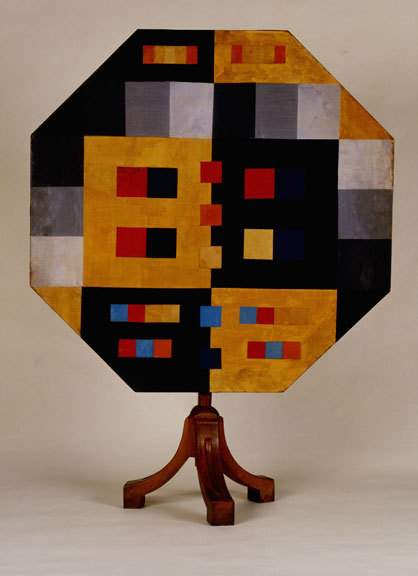
Unknown: Schirm zur Farbenlehre auf Holzfuss (Screen on colour theory mounted on wooden stand), 1791/92 or 1805/06. Wood, canvas, paper 73 x 72 x 2.5 x 2.5 cm Stand:65.5 x 35 cm © Klassik Stiftung Weimar
דThe Bauhaus comes from Weimar” will present familiar and less familiar facets of the early Bauhaus in five venues: Bauhaus Museum (visitors’ information, comic panorama and introductory film), Goethe National Museum (visual arts, colour- and metamorphosis theories), Neues Musum (workshops), Schiller Museum (play, parties and stage) and the Haus am Horn (housing development history and architecture). Covering an area totalling 3,400 square metres, almost 1,200 objects from international collections will shown, including loans from the Museum of Modern Art and the Metropolitan Museum in New York, the Centre Georges Pomipdou in Paris, the Museo Thyssen-Bornemisza in Madrid, and the Josef and Anni Albers Foundation in Bethany, USA. In particular, the Bauhaus Archive in Berlin supported the exhibition with its loans, along with the Theaterwissenschaftliche Sammlung (Theater Studies Collection) of the University of Cologne, the Paul Klee Centre in Bern, the Stiftung Bauhaus Dessau, the Staatlichen Kunstsammlungen Dresden, the Staatlichen Museen Berlin and the Daimler Kunst Sammlung.
László Moholy-Nagy: Nickel-Plastik (Nickel sculpture), 1921, The Museum of Modern Art, New York, Gift of Mrs. Sibyl Moholy-Nagy, 1956. Nickel sculpture, nickel-plated iron, welded 35.9 x 17.5 x 23.8 cm © VG Bild-Kunst, Bonn 2009
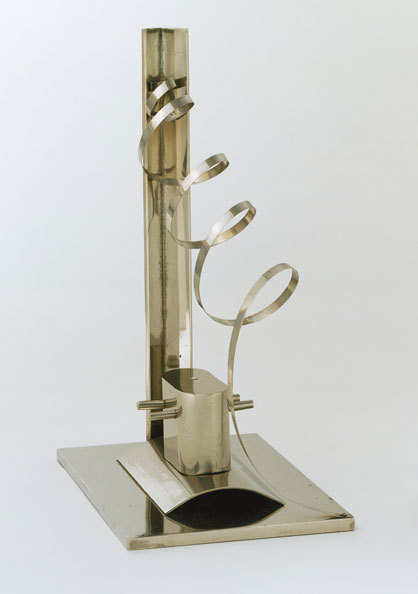
László Moholy-Nagy: Nickel-Plastik (Nickel sculpture), 1921, The Museum of Modern Art, New York, Gift of Mrs. Sibyl Moholy-Nagy, 1956. Nickel sculpture, nickel-plated iron, welded 35.9 x 17.5 x 23.8 cm © VG Bild-Kunst, Bonn 2009
×The Bauhaus Museum serves as a visitors’ welcome centre, providing an introduction to and information about the exhibition. A walk-in comic panorama based on historical photographs and quotes was developed by the Cologne agency AreWeDesigner | European Design Hasardeure.
A film produced especially for the exhibition by the Weimar-based company, ostlicht filmproduktion, offers insights into the history of the Weimar Republic and the Bauhaus. Among other elements, the film uses historical film material dating from the 1920s to the 1960s, including interviews with Walter Gropius and Felix Klee as well as material from private archives, e.g. pictures of the Haus Am Horn, which has not yet been publicly shown.
Masterworks of the Bauhaus masters’ visual art – paintings, sculptures, graphic art and photographs – are exhibited in the Goethe National Museum. Works by Gerhard Marcks, Lyonel Feininger, Johannes Itten, Georg Muche, Lothar Schreyer, Paul Klee, Oskar Schlemmer, Wassily Kandinsky und László Moholy-Nagy demonstrate the tendency towards constructivism and new figurativism, among other things, thus showing the complexity of the Weimar Bauhaus. Another part of the exhibition illustrates the significance of Goethe’s colour theory and morphology for early designs.
Wassily Kandinsky: Bilder einer Ausstellung (Pictures at an Exhibition), Stage design for scene XVI: The great gate of Kiev, ca. 1930, Theaterwissenschaftliche Sammlung, University of Cologne
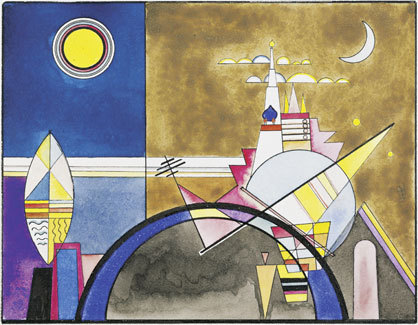
Wassily Kandinsky: Bilder einer Ausstellung (Pictures at an Exhibition), Stage design for scene XVI: The great gate of Kiev, ca. 1930, Theaterwissenschaftliche Sammlung, University of Cologne
×The development of the work process at the Bauhaus workshops leading from the early, altogether very expressive works to the later design becomes clear in the Neues Museum. In particular, the metal workshop and the cabinetmakers’ workshop produced objects that have become classics in design history, including the famous Bauhaus lamp by Wilhelm Wagenfeld. In some workshops, for example the ceramic workshop, the path to serial production was sought very early on. Already Henry van de Velde’s school for arts and crafts gave the impulse for a new approach to product design in Weimar, which is shown in the exhibition. A special highlight in the Neues Museum are the carpets from the Bauhaus collection of the Klassik Stiftung, which were restored for the exhibition with the support of the Vorwerk Teppichwerke.
The Schiller Museum focuses on the area of play, parties and stage at the Bauhaus. The desire to experiment and socialize, an important aspect of life at the Bauhaus, becomes apparent here. Visions and utopias were expressed on stage as well as at creative parties. Stage works by Lothar Schreyer, examples of student works for the “Mechanical Ballet” and the marionette stage, stage works by Oskar Schlemmer and Wassily Kandinsky as well as utopian stage projects by László Moholy-Nagy and designs for theatre spaces by Walter Gropius and Andor Weininger can be seen.
Paul Klee: Rosenwind (Rose wind), 1922, 39, Zentrum Paul Klee, Bern. Gift of Livia Klee, Oil on base coat on paper on cardboard 38.2 x 41.8 cm © VG Bild-Kunst, Bonn 2009
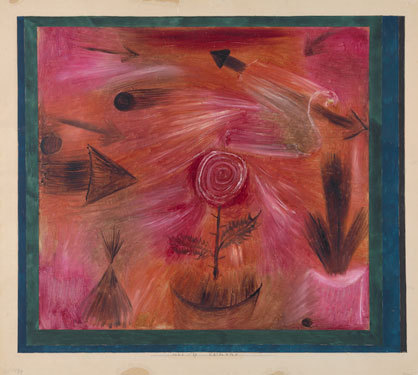
Paul Klee: Rosenwind (Rose wind), 1922, 39, Zentrum Paul Klee, Bern. Gift of Livia Klee, Oil on base coat on paper on cardboard 38.2 x 41.8 cm © VG Bild-Kunst, Bonn 2009
×Finally, with the Bauhaus-Universität Weimar and the Freundeskreis of the Bauhaus-Universität, have collaborated to focus on the subject of architecture in the Haus am Horn. Although architecture was not introduced as a subject until 1927 in Dessau, an introductory course was already offered to students by Walter Gropius and Adolf Meyer in Weimar. The history of the Haus am Horn, which was built in 1923 with the participation of all the Bauhaus workshops, and which is considered the earliest existing evidence of Bauhaus architecture, will be shown in this context along with drafts for a Bauhaus housing development in Weimar.
The exhibition integrates contemporary works by students of the Bauhaus-Universität Weimar. Accordingly, in the stairwell of the Goethe National Museum, a work by the artist Kathrin Heesch can be seen, who developed a colour theory inspired by the Bauhaus. A contemporary interpretation of László Moholy-Nagy’s utopian stage projects by the artist-duo schroeter und berger is shown on the third floor of the Schiller Museum. In the basement of the Neues Museum, “marke.6”, the student gallery of the Bauhaus-Universität, presents film experiments and architectural cinema designs of the historical Bauhaus vis à vis works by contemporary artists, film makers and designers.
The exhibition architecture of “The Bauhaus comes from Weimar” was produced by the Cologne office meyer voggenreiter projekte. It seeks to support the dialogue between the viewer and the object and thus chooses a system of very few elements. In order to identify and connect the various locations of the exhibition, so-called “text hedges” have been installed in front of the Bauhaus Museum, the Goethe National Museum, the Neues Museum and the Schiller Museum. The installations, developed by the exhibition architects in cooperation with the BEL office, employ quotes by Walter Gropius. The “text hedges” reflect the relationship of the Bauhaus to Weimar as a cultural venue of language and literature and equally importantly, as a location in real terms. The quote is a popular means of publicizing subjects and contents in Weimar. On the other hand, text was also an important means of expression and propaganda for the Bauhaus, especially in the form of its manifesto.
The exhibition “The Bauhaus comes from Weimar” is flanked by a multifarious programme that is designed to relate diverse aspects of the style-setting art school to a wide audience. The offerings include tours guided by curators, puppet shows using reproductions of the puppets that Paul Klee constructed for his son Felix, a BAUHAUS-Menu centred around the subject of living culture at the Bauhaus, the bauhaus-bags, the open workshop in the Schiller Museum, concerts, lectures, readings, and a Bauhaus Night.
Johannes Itten: Farbenkugel in 7 Lichtstufen und 12 Tönen (Colour sphere in 7 light stages and 12 tones), 192, Klassik Stiftung Weimar. Lithograph 47 x 32 © VG Bild-Kunst, Bonn 2009
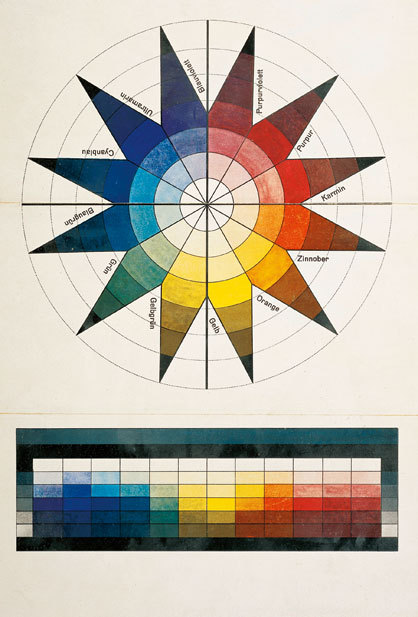
Johannes Itten: Farbenkugel in 7 Lichtstufen und 12 Tönen (Colour sphere in 7 light stages and 12 tones), 192, Klassik Stiftung Weimar. Lithograph 47 x 32 © VG Bild-Kunst, Bonn 2009
×The exhibition is documented by a comprehensive catalogue. In chapters corresponding to those of the exhibition, it leads through the history of the school until its banishment in 1925 and at the same time, points out the manifold relationships of the Bauhaus to the tradition-laden setting of Weimar. It focuses on the comprehensive portrayal of the Bauhaus workshops, the development of the educational profile and the legendary introductory courses as well as the oeuvres of the Bauhaus masters. In the process, the authors examine the connection of each individual artistic and pedagogical position to Weimar’s classical inheritance.
The Jahrbuch 2009 of the Klassik Stiftung, “Klassik und Avantgarde. Das Bauhaus in Weimar 1919-1925” (“The Classics and the Avant Garde. The Bauhaus in Weimar 1919-1925”) including articles by Magdalena Droste and Wolfgang Pehnt, also illustrates the many-faceted artistic work at the Weimar Bauhaus and examines the difficult relationship between the state art school and the contemporary public.
The bilingual children’s catalogue on the Bauhaus is a very special publication, written by children for children and developed in the course of a cooperative project of the Klassik Stiftung Weimar with the thuringia international school weimar, ThIS.
The principal sponsors of the exhibition “The Bauhaus comes from Weimar” are the Sparkassen Financial Group, the State of Thuringia and the Ernst von Siemens Kunststiftung. The restoration of the Bauhaus carpets from the collection of the Klassik Stiftung was made possible by the friendly support of Vorwerk & Co. KG, Hameln.
Peter Keler: Kinderwiege (Child’s cradle) 1922. Wood, painted in colour, woven sides 91.7 x 91.7 x 98 cm © Klassik Stiftung Weimar

Peter Keler: Kinderwiege (Child’s cradle) 1922. Wood, painted in colour, woven sides 91.7 x 91.7 x 98 cm © Klassik Stiftung Weimar
×Exhibition Information
1 April until 5 July 2009
Tuesday through Sunday, 11am – 6pm
Bauhaus Museum | Am Theaterplatz | 99423 Weimar
Neues Museum Weimar | Weimarplatz 5 | 99423 Weimar
Schiller Museum | Schillerstraße 12 | 99423 Weimar
Goethe National Museum | Frauenplan 1 | 99423 Weimar
Haus Am Horn | Am Horn | 99423 Weimar
Catalogue Information
“The Bauhaus comes from Weimar”
With articles by Ute Ackermann, Ulrike Bestgen, Thomas Föhl, Gisela Maul, Nicole Mende, Sabine Schimma, Michael Siebenbrodt und Dorothea Stoeber.
380 pages with 343 colour and 167 black and white illustrations, 35 €
ISBN: 978-3-422-06883-4
Jahrbuch 2009
Klassik und Avantgarde. Das Bauhaus in Weimar 1919 – 1925.
Edited by Hellmut Th. Seemann and Thorsten Valk
Wallstein Verlag, 28 €
ISBN: 978-3-8353-04512
Bilingual Children’s Catalogue on the Bauhaus in Weimar
(also available after the termination of the exhibition “The Bauhaus comes from Weimar”)
»Half-moon, red wings, form and function – Weißt Du, was das Bauhaus ist?«
Editing: Nadja Kupsch, Klassik Stiftung | Bernd Helmbold, ThIS
38 pages, Ger/Eng, 8 €
Wilhelm Wagenfeld: Table lamp (Glass version MT9/ME1), 1923/24, Klassik Stiftung Weimar. Nickel-plated brass, various types of glass H 38 cm © VG Bild-Kunst, Bonn 2009
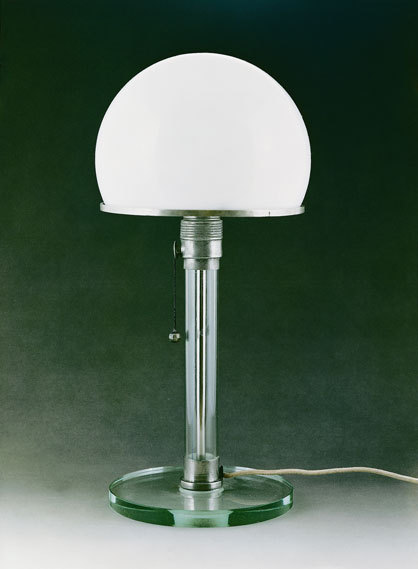
Wilhelm Wagenfeld: Table lamp (Glass version MT9/ME1), 1923/24, Klassik Stiftung Weimar. Nickel-plated brass, various types of glass H 38 cm © VG Bild-Kunst, Bonn 2009
×Unknown: The life at the Weimar Bauhaus: members of the Bauhaus and guests, around 1922 Photographic paper (with silver halide salts in gelatin) Print: 11.1 x 8.4 cm © Bauhaus-Archive Berlin
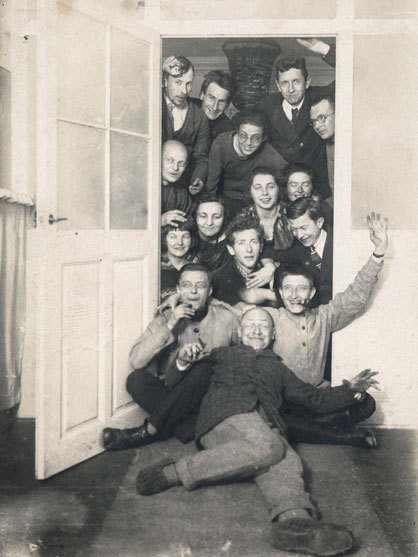
Unknown: The life at the Weimar Bauhaus: members of the Bauhaus and guests, around 1922 Photographic paper (with silver halide salts in gelatin) Print: 11.1 x 8.4 cm © Bauhaus-Archive Berlin
×